 |
Kage Studio 0.7.240121
A Simple Free and Open Source 2D Animation Software
|
 |
Kage Studio 0.7.240121
A Simple Free and Open Source 2D Animation Software
|
#include <scene.h>
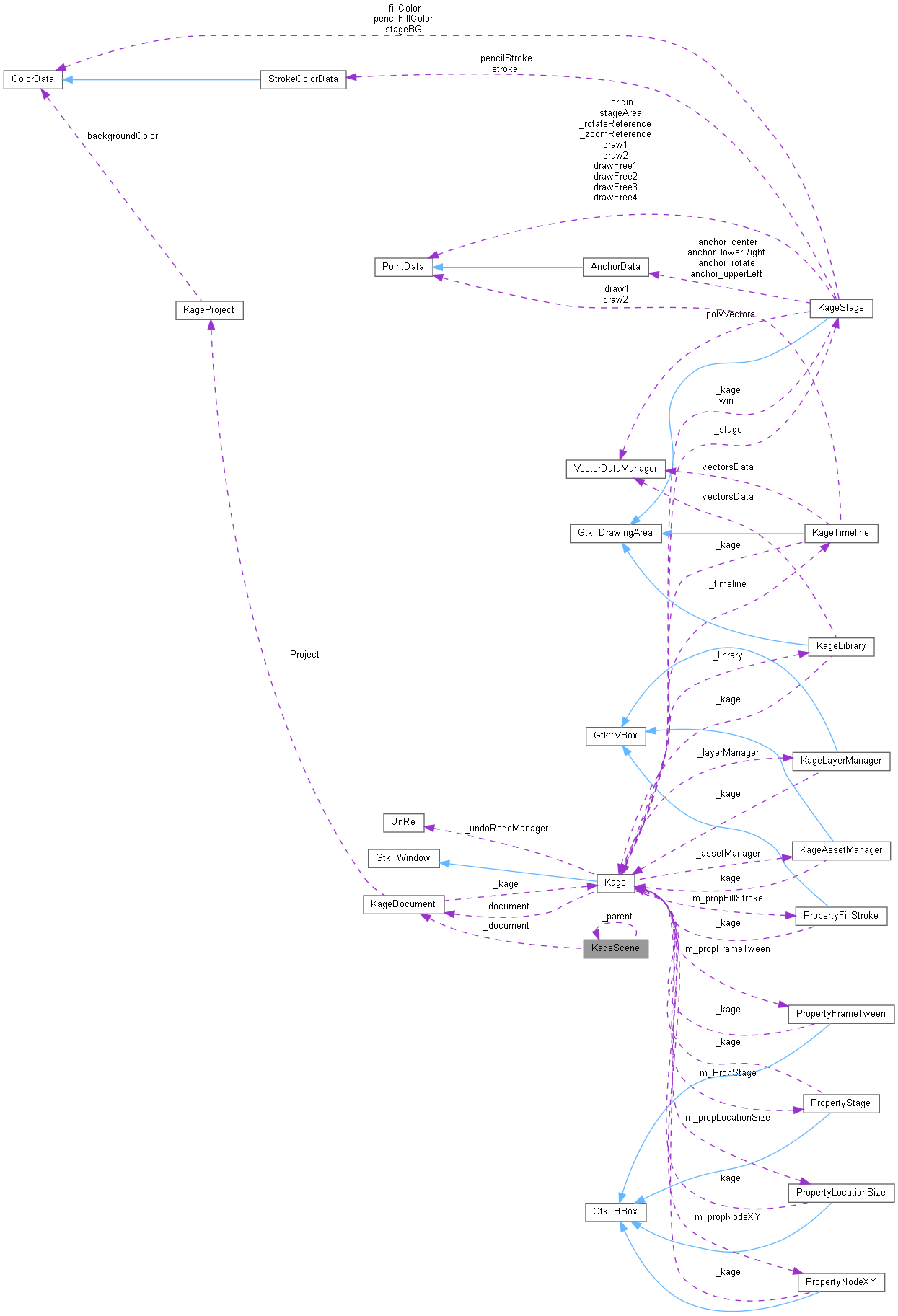
Public Member Functions | |
| void | init (KageDocument *p_document, unsigned int p_sceneID) |
| KageScene (KageDocument *p_document, unsigned int p_sceneID, std::string p_filepath) | |
| KageScene | operator= (const KageScene &p_scene) |
| unsigned int | getID () |
| bool | open (std::string p_filepath) |
| bool | save () |
| void | setSelected (bool p_selected) |
| bool | isSelected () |
| bool | isSaved () |
| KageScene (KageDocument *p_document, unsigned int p_sceneID) | |
| KageScene (KageDocument *p_document, unsigned int p_sceneID, KageScene *p_scene) | |
| virtual | ~KageScene () |
| void | addLayer () |
| void | deleteLayer (unsigned int p_layerID) |
| bool | removeLayerAt (unsigned int p_layerIndex) |
| bool | addLayerFrame () |
| bool | extendLayerFrame () |
| bool | duplicateLayerFrame () |
| bool | removeLayerFrame () |
| void | setLayerCurrentFrame (unsigned int p_frame, bool p_addSelected) |
| void | setCurrentFrameByID (unsigned int p_frameID) |
| unsigned int | getCurrentFrame () |
| void | setCurrentLayer (unsigned int p_currentLayer, bool p_addSelected) |
| void | setCurrentLayerByID (unsigned int p_layerID) |
| unsigned int | getCurrentLayer () |
| unsigned int | frameCount () |
| void | selectAllLayerFrame (bool p_selectAll) |
| KageFrame * | getFrame () |
| KageFrame * | getFrameAt (unsigned int p_frame) |
| KageLayer * | getLayer () |
| KageLayer * | getLayerAt (unsigned int p_layer) |
| bool | removeAllFrames () |
| bool | moveToTop () |
| bool | moveUp () |
| bool | moveDown () |
| bool | moveToBottom () |
| std::vector< unsigned int > | raiseSelectedShape (std::vector< unsigned int > p_selectedShapes) |
| std::vector< unsigned int > | lowerSelectedShape (std::vector< unsigned int > p_selectedShapes) |
| std::vector< unsigned int > | raiseToTopSelectedShape (std::vector< unsigned int > p_selectedShapes) |
| std::vector< unsigned int > | lowerToBottomSelectedShape (std::vector< unsigned int > p_selectedShapes) |
| std::vector< unsigned int > | groupSelectedShapes (std::vector< unsigned int > p_selectedShapes) |
| std::vector< unsigned int > | ungroupSelectedShapes (std::vector< unsigned int > p_selectedShapes) |
| std::vector< unsigned int > | duplicateShapes (std::vector< unsigned int > p_selectedShapes) |
| bool | flipHorizontalSelectedShape (std::vector< unsigned int > p_selectedShapes) |
| bool | flipVerticalSelectedShape (std::vector< unsigned int > p_selectedShapes) |
| bool | recenterRotationPoint (std::vector< unsigned int > p_selectedShapes) |
| bool | addDataToFrame (VectorDataManager p_vectorsData) |
| bool | setFrameData (VectorDataManager p_vectorsData) |
| VectorDataManager | getFrameData () |
| VectorDataManager | getFrameDataAt (unsigned int p_frame, bool p_frameOnion, bool p_layerOnion) |
| bool | forceSetTween (unsigned int p_tween) |
| NOTE: "Frame" – NOT "frame ID". | |
| bool | setTween (unsigned int p_tween) |
| unsigned int | getTween () |
| bool | layerSwitchToPreviousFrame () |
| bool | layerSwitchToPreviousFrame (unsigned int p_frameID) |
| Called by Kage for navigating to Previous Frame. | |
| bool | layerSwitchToNextFrame () |
| Called by KageFrame for navigating to Previous Frame. | |
| bool | layerSwitchToNextFrame (unsigned int p_frameID) |
| Called by Kage for navigating to Next Frame. | |
| void | setFrameExtension (KageFrame::extension p_extension) |
| Called by KageFrame for navigating to Next Frame. | |
| void | extendFrameAt (unsigned int p_layerIndex, unsigned int p_frameIndex, unsigned int p_frameCount) |
| will be called from KageTimeline from mouse gesture of stretching the frame | |
| unsigned int | getActiveLayerID () |
| std::string | getLayerLabel () |
| void | setLayerLabel (std::string p_label) |
| void | toggleLayerVisibility () |
| bool | isLayerVisible () |
| void | setLayerVisible (bool p_visible) |
| void | toggleLayerLock () |
| bool | isLayerLocked () |
| void | setLayerLocked (bool p_locked) |
| std::string | getLabel () |
| void | setLabel (std::string p_label) |
Data Fields | |
| unsigned int | sceneID |
| bool | _selected |
| bool | _saved |
| unsigned int | _activeLayerID |
| unsigned int | _activeLayerIndex |
| unsigned int | _activeLayer |
| unsigned int | layerCtr |
| std::string | _label |
| will be used to create Unique LayerUI IDs | |
| std::vector< KageLayer * > | Layers |
| KageLayer * | _layerPtr |
| KageDocument * | _document |
| KageScene * | _parent |
| bool | _isAsset |
Static Public Attributes | |
| static bool | LOADING_MODE = false |
| static std::vector< unsigned int > | sceneStack = {} |
| KageScene::KageScene | ( | KageDocument * | p_document, |
| unsigned int | p_sceneID, | ||
| std::string | p_filepath ) |


| KageScene::KageScene | ( | KageDocument * | p_document, |
| unsigned int | p_sceneID ) |

| KageScene::KageScene | ( | KageDocument * | p_document, |
| unsigned int | p_sceneID, | ||
| KageScene * | p_scene ) |

|
virtual |
| bool KageScene::addDataToFrame | ( | VectorDataManager | p_vectorsData | ) |

| void KageScene::addLayer | ( | ) |


| bool KageScene::addLayerFrame | ( | ) |
NOTE: why duplicate?

| void KageScene::deleteLayer | ( | unsigned int | p_layerID | ) |
| bool KageScene::duplicateLayerFrame | ( | ) |

| std::vector< unsigned int > KageScene::duplicateShapes | ( | std::vector< unsigned int > | p_selectedShapes | ) |

| void KageScene::extendFrameAt | ( | unsigned int | p_layerIndex, |
| unsigned int | p_frameIndex, | ||
| unsigned int | p_frameCount ) |
will be called from KageTimeline from mouse gesture of stretching the frame
| p_layerIndex | 0 to Layer size less 1 |
| p_frameCount | how many frames to stretch |
| bool KageScene::extendLayerFrame | ( | ) |

| bool KageScene::flipHorizontalSelectedShape | ( | std::vector< unsigned int > | p_selectedShapes | ) |

| bool KageScene::flipVerticalSelectedShape | ( | std::vector< unsigned int > | p_selectedShapes | ) |

| bool KageScene::forceSetTween | ( | unsigned int | p_tween | ) |
NOTE: "Frame" – NOT "frame ID".

| unsigned int KageScene::frameCount | ( | ) |

| unsigned int KageScene::getActiveLayerID | ( | ) |

| unsigned int KageScene::getCurrentFrame | ( | ) |

| unsigned int KageScene::getCurrentLayer | ( | ) |
For use of Kage. To keep track of active Layer in-check of all layers in Scene

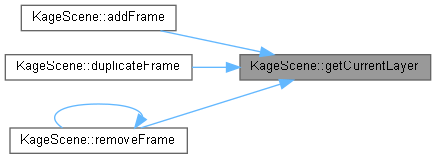
| KageFrame * KageScene::getFrame | ( | ) |

| KageFrame * KageScene::getFrameAt | ( | unsigned int | p_frame | ) |

| VectorDataManager KageScene::getFrameData | ( | ) |

| VectorDataManager KageScene::getFrameDataAt | ( | unsigned int | p_frame, |
| bool | p_frameOnion, | ||
| bool | p_layerOnion ) |
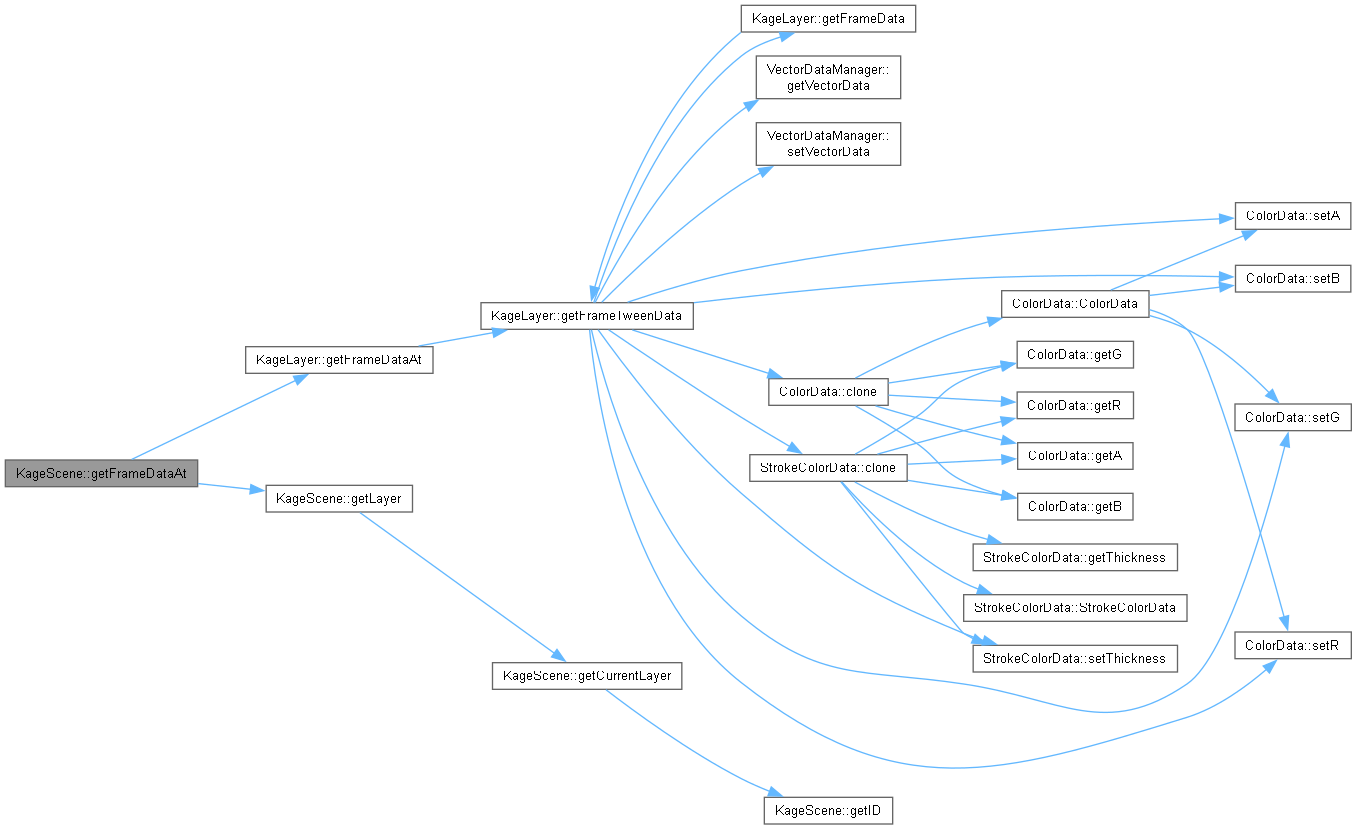
| unsigned int KageScene::getID | ( | ) |
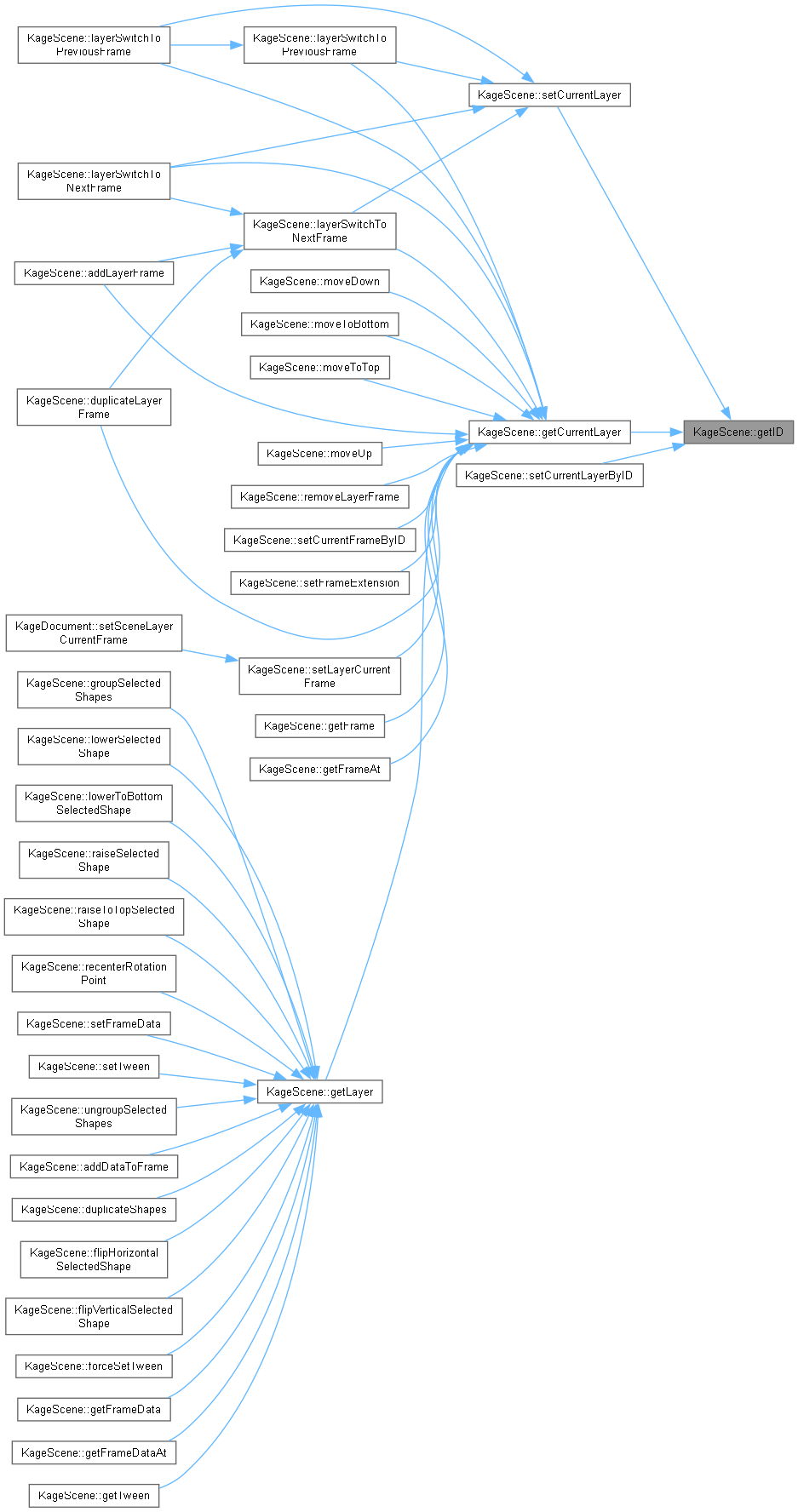
| std::string KageScene::getLabel | ( | ) |

| KageLayer * KageScene::getLayer | ( | ) |

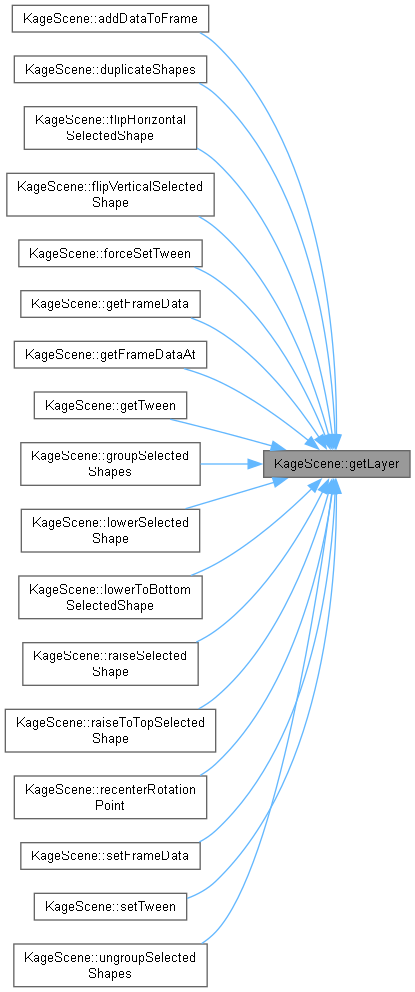
| KageLayer * KageScene::getLayerAt | ( | unsigned int | p_layer | ) |
| std::string KageScene::getLayerLabel | ( | ) |

| unsigned int KageScene::getTween | ( | ) |

| std::vector< unsigned int > KageScene::groupSelectedShapes | ( | std::vector< unsigned int > | p_selectedShapes | ) |

| void KageScene::init | ( | KageDocument * | p_document, |
| unsigned int | p_sceneID ) |


| bool KageScene::isLayerLocked | ( | ) |

| bool KageScene::isLayerVisible | ( | ) |

| bool KageScene::isSaved | ( | ) |
| bool KageScene::isSelected | ( | ) |

| bool KageScene::layerSwitchToNextFrame | ( | ) |
Called by KageFrame for navigating to Previous Frame.

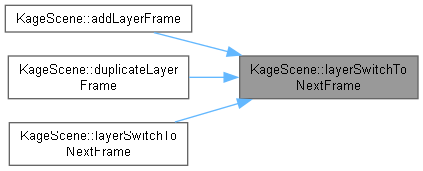
| bool KageScene::layerSwitchToNextFrame | ( | unsigned int | p_frameID | ) |
| bool KageScene::layerSwitchToPreviousFrame | ( | ) |


| bool KageScene::layerSwitchToPreviousFrame | ( | unsigned int | p_frameID | ) |
| std::vector< unsigned int > KageScene::lowerSelectedShape | ( | std::vector< unsigned int > | p_selectedShapes | ) |

| std::vector< unsigned int > KageScene::lowerToBottomSelectedShape | ( | std::vector< unsigned int > | p_selectedShapes | ) |

| bool KageScene::moveDown | ( | ) |
NOTE: KageFrameset are organized as index 0 as BOTTOM and last index is TOP

| bool KageScene::moveToBottom | ( | ) |
NOTE: KageFrameset are organized as index 0 as BOTTOM and last index is TOP

| bool KageScene::moveToTop | ( | ) |
NOTE: KageFrameset are organized as index 0 as BOTTOM and last index is TOP

| bool KageScene::moveUp | ( | ) |
NOTE: KageFrameset are organized as index 0 as BOTTOM and last index is TOP

| bool KageScene::open | ( | std::string | p_filepath | ) |


| std::vector< unsigned int > KageScene::raiseSelectedShape | ( | std::vector< unsigned int > | p_selectedShapes | ) |

| std::vector< unsigned int > KageScene::raiseToTopSelectedShape | ( | std::vector< unsigned int > | p_selectedShapes | ) |

| bool KageScene::recenterRotationPoint | ( | std::vector< unsigned int > | p_selectedShapes | ) |

| bool KageScene::removeAllFrames | ( | ) |
| bool KageScene::removeLayerAt | ( | unsigned int | p_layerIndex | ) |

| bool KageScene::removeLayerFrame | ( | ) |

| bool KageScene::save | ( | ) |
| void KageScene::selectAllLayerFrame | ( | bool | p_selectAll | ) |

| void KageScene::setCurrentFrameByID | ( | unsigned int | p_frameID | ) |
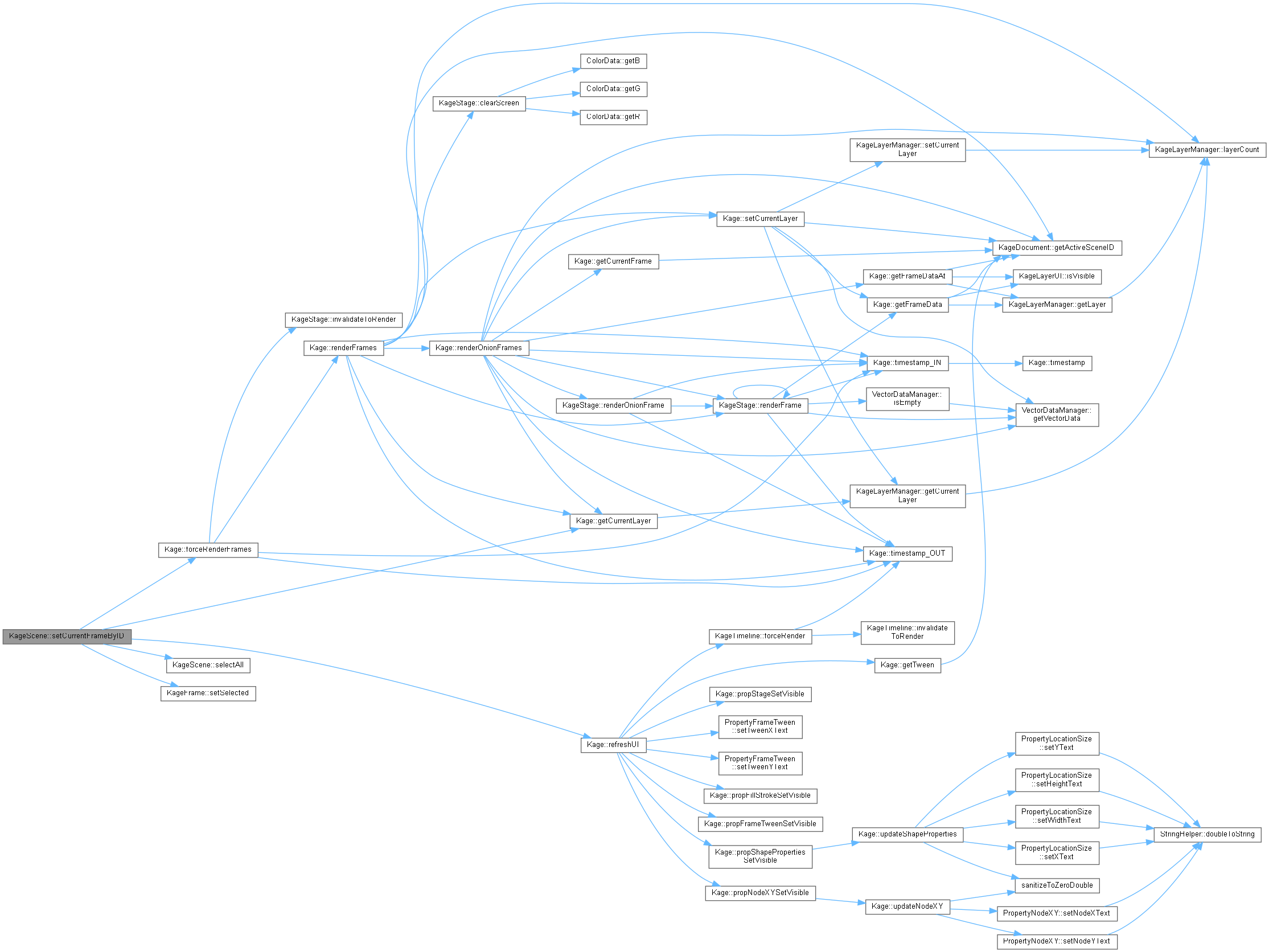
| void KageScene::setCurrentLayer | ( | unsigned int | p_currentLayer, |
| bool | p_addSelected ) |
For use of Kage.
| p_layer | is index+1 of active layer |
| p_addSelected | select another Layer or not |


| void KageScene::setCurrentLayerByID | ( | unsigned int | p_layerID | ) |

| bool KageScene::setFrameData | ( | VectorDataManager | p_vectorsData | ) |

| void KageScene::setFrameExtension | ( | KageFrame::extension | p_extension | ) |
| void KageScene::setLabel | ( | std::string | p_label | ) |

| void KageScene::setLayerCurrentFrame | ( | unsigned int | p_frame, |
| bool | p_addSelected ) |
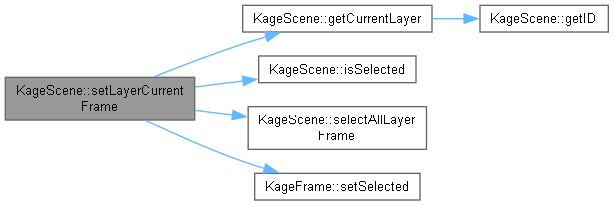

| void KageScene::setLayerLabel | ( | std::string | p_label | ) |

| void KageScene::setLayerLocked | ( | bool | p_locked | ) |

| void KageScene::setLayerVisible | ( | bool | p_visible | ) |

| void KageScene::setSelected | ( | bool | p_selected | ) |

| bool KageScene::setTween | ( | unsigned int | p_tween | ) |

| void KageScene::toggleLayerLock | ( | ) |

| void KageScene::toggleLayerVisibility | ( | ) |

| std::vector< unsigned int > KageScene::ungroupSelectedShapes | ( | std::vector< unsigned int > | p_selectedShapes | ) |

| unsigned int KageScene::_activeLayer |
| unsigned int KageScene::_activeLayerID |
| unsigned int KageScene::_activeLayerIndex |
| KageDocument* KageScene::_document |
| bool KageScene::_isAsset |
| std::string KageScene::_label |
will be used to create Unique LayerUI IDs
| KageLayer* KageScene::_layerPtr |
| KageScene* KageScene::_parent |
| bool KageScene::_saved |
| bool KageScene::_selected |
| unsigned int KageScene::layerCtr |
| std::vector<KageLayer *> KageScene::Layers |
|
static |
| unsigned int KageScene::sceneID |
|
static |